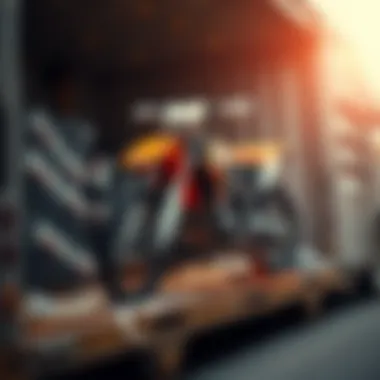Essential Steps for Shipping a Dirt Bike Successfully


Intro
Shipping a dirt bike isn't just about getting it from point A to point B; it's about doing so with care and precision. Whether you're moving your prized possession across the country or prepping it for a racing event, shipping involves more than slapping a label on a box. There are numerous aspects to consider. This guide aims to provide a clear, step-by-step process to navigate the intricacies involved in transporting your motorcycle safely.
When you think about all the bumps along the road—literally and figuratively—preparation can make all the difference. From securing your bike properly to understanding shipping regulations, a thorough approach will help you safeguard your investment and avoid mishaps.
Let’s dive in and unravel the nuts and bolts of effective dirt bike shipping.
Understanding the Importance of Proper Shipping
When it comes to dirt biking, ensuring your bike’s safe journey is paramount. Proper shipping is not just a mere task; it’s a vital part of preserving your investment. Mishaps in shipping can lead to costly repairs or even loss of your beloved bike. A well-thought-out shipping process ensures that your bike arrives at its destination in top condition.
Why Shipping Method Matters
Choosing the right shipping method can significantly impact the delivery time, safety, and overall cost of transporting your dirt bike. Different methods suit varied needs:
- Ground Shipping: Often the most economical choice, ground shipping can be reliable but may take longer.
- Air Freight: While costing more, this method guarantees faster delivery.
- Door-to-Door vs. Terminal-to-Terminal: With door-to-door, you avoid the hassle of transporting your bike to a terminal, while terminal-to-terminal might save some cash but adds to your legwork.
Evaluating these options isn't merely about picking the cheapest route. For instance, if you’re in a rush to transport your bike for a competition, air freight may be your best bet despite the higher cost. Thus, aligning your shipping method with your immediate needs is essential.
Potential Risks of Poor Shipping Practices
Neglecting the intricacies of proper shipping can result in various unfortunate events.
- Damage During Transit: If your bike isn’t adequately secured or packed, it could suffer damage. Not to mention, frame bends and engine issues can become a real headache if the correct packing is ignored.
- Regulatory Problems: Shipping your bike without understanding the legalities can lead to fines or even confiscation in certain jurisdictions.
- Loss of Insurance: Not taking the right precautions may void your insurance. If something goes wrong during transport, you might find yourself footing the bill without any recourse.
To reiterate, taking a skimpier approach to the logistics of shipping your dirt bike is like playing with fire. Not only do you risk damaging a costly asset, but the consequences could also run deeper into worrying about deadlines and added expenses.
Investing time in proper shipping is investing in peace of mind. Make the effort, and your bike will thank you.
By understanding the importance and risks associated with shipping, you not only safeguard your investment but also facilitate a smoother transport experience.
Preparing Your Dirt Bike for Shipment
When it comes to shipping a dirt bike, preparation is paramount. Think of your bike as a delicate piece of machinery; just like you wouldn't toss your expensive watch in a backpack without protection, you shouldn't just throw your dirt bike into a truck. This section emphasizes the significance of adequately preparing your dirt bike for shipment. A thorough preparation can prevent damage during transit, ensure a smoother transition, and help you avoid potential headaches along the way.
Cleaning the Bike
Before you even consider boxing up your dirt bike, it’s essential to give it a good cleaning. Not only does this improve its aesthetic appeal, but it also serves a practical purpose—removing dirt and grime allows for better inspection, which is crucial for spotting any existing damage. When you wash the dirt bike, pay particular attention to the undercarriage and wheel spokes, where dirt tends to hide.
Be careful to use mild soap and avoid high-pressure jets, which might force water into sensitive areas. After cleaning, dry it thoroughly. Water settles in crevices and can cause rust or other issues down the line.
Inspecting for Damage
A careful inspection of your bike should follow the cleaning process. This isn't a quick once-over; you need to look closely at all components. Check the frame for any dents or scratches, look at the suspension for any signs of wear, and thoroughly inspect the engine and exhaust. Even a minor issue could escalate during shipment, leading to costly repairs later.
Taking photographs of your bike before shipping can also be beneficial. These images serve as a record of its condition and can be invaluable for insurance claims if any damage does occur while in transit.
Removing Accessories
Next, consider removing any accessories that can be easily detached. This may include handlebar grips, lights, or even the battery. Accessories like these can get damaged during shipping, and losing them can be a nuisance. Not to mention they can add extra weight and complicate packaging efforts.
Make sure to store these items in a clearly labeled box to prevent them from getting mixed up or lost. Doing this not only protects the items but also helps in the efficient unpacking process once your dirt bike has arrived at its destination.
Defueling the Tank
Lastly, one of the most critical steps before shipping a dirt bike is defueling the tank. This is not just a safety measure; it’s often a legal requirement for shipping companies. A full tank can lead to spills, potential fire hazards, and an array of regulatory complications.
You should drain the tank completely. If there's a lot of fuel left, consider using it in your bike for your next ride instead of wasting it. Always refer to your local regulations regarding fuel disposal if you need to get rid of it.
"A well-prepped bike is half the battle won; it’s all about giving yourself peace of mind and ensuring your ride arrives safe and sound."
Thinking through each of these steps helps not just in safeguarding your dirt bike but also in smoothening the logistics later on. This preparation is crucial; it keeps your bike looking sharp and ready for the trails upon arrival.
Selecting the Right Shipping Method
Choosing the right shipping method for your dirt bike is crucial. It influences not just the cost but also the safety of the bike during transportation. With a range of options available, it’s important to weigh the pros and cons of each to avoid any unnecessary headaches down the road.


- Cost Efficiency: Different methods come with different price tags. Ground shipping tends to be more economical, while air freight can be pricier. Depending on your budget, one could be a better fit than the other.
- Time Consideration: If you need your dirt bike in a hurry, air freight might be the way to go. It’s faster, getting your bike from point A to point B in a fraction of the time compared to ground methods.
- Safety of the Bike: The method you choose also impacts how well your bike is protected. While ground shipping might be steady, airfreight could introduce vibrations and pressure changes that don’t sit well with every bike. Evaluating the level of security offered by each method can be a game changer in your decision.
Addressing these considerations will help you select the most suitable option, ensuring a smooth transportation experience for your dirt bike.
Ground Shipping
Transporting a dirt bike via ground shipping is often the preferred method for many due to its balance of cost and reliability. It is primarily executed through specialized carriers that are tailored to handle motorized vehicles, ensuring the bike is secure throughout its journey.
- Cost-Effective: As one of the most affordable options available, ground shipping can save you a few bucks. You won't be breaking the bank with this choice.
- Availability: Most regional and local carriers offer this service, meaning you have a wide array of options to consider.
- Ease of Logistics: Ground shipping is generally straightforward. Often, you won’t need to deal with the complexities of loading and unloading at cargo terminals.
However, it's worth noting that ground shipping can be slower. Depending on the distance, expect to wait a bit longer for your bike to arrive.
Air Freight
Air freight is an option that some dirt bike enthusiasts turn to, especially when time is of the essence. Shipping your bike through airlines means it can reach its destination in a flash.
- Speed: If you need your bike for a competition or event, air freight is the best bet, getting it there in the shortest time possible.
- Global Reach: You can ship your dirt bike internationally with air freight, making it perfect for overseas racers or buyers.
However, it isn’t without its downsides.
- Cost: This method can be significantly more expensive compared to ground options, so keep that in mind if you're trying to stick to a budget.
- Delivery Limitations: Not all airlines accept bikes, so it’s essential to check in advance to avoid surprises.
Door-to-Door vs. Terminal-to-Terminal
When opting for shipping methods, understanding the difference between door-to-door and terminal-to-terminal transport can help you make an informed choice.
- Door-to-Door: This service means the shipping company will pick up your dirt bike from your home and deliver it straight to the destination. It offers convenience but might come at an added cost.
- Terminal-to-Terminal: In contrast, terminal-to-terminal means you’ll need to drop off your bike at a shipping terminal and then pick it up at another terminal at the destination. This option can be more economical but usually involves a bit more legwork on your part.
Understanding the differences in these delivery options can help streamline the shipping process, ensuring you choose the best service for your needs.
Ultimately, selecting the right shipping method for your dirt bike isn’t just about cost; it’s about balancing speed, safety, and convenience. Be sure to think through your options carefully to ensure you make the best choice.
Packing Techniques for a Dirt Bike
When it comes to shipping a dirt bike, packing it properly is essential. One might think it's just a matter of tossing the bike into a box and calling it a day. But let me tell you, that’s as far from the truth as night is from day. Effective packing techniques not only protect your bike but also ensure a smooth journey to its destination. This section will explore choosing the right crate, securing the bike, and protecting sensitive parts—each playing a crucial role in the safe transport of your prized possession.
Choosing the Right Crate
Selecting the appropriate crate is the first step towards ensuring that your dirt bike arrives safe and sound. Crates can come in various shapes and sizes, but you want one that offers both strength and support. Look for a crate that’s sturdy enough to handle the weight and the inevitable jolts of transport.
Here are a few key considerations:
- Material: Opt for wood or heavy-duty plastic. Wood can absorb shocks better, while plastic might be lighter.
- Size: Ensure the dimensions allow your bike to fit snugly but not too tightly, with some room for packing materials around.
- Accessibility: The crate should allow easy loading and unloading—nobody wants to wrestle with a stubborn lid.
Securing the Bike in the Crate
Once you’ve got the right crate, it’s time to secure your bike. This step is crucial; a loose bike bouncing around like a pinball can lead to serious damage. Here’s how to do it:
- Positioning: Start by placing the bike on its side stand or center stand. Only one stand should be used at any given time.
- Straps and Tie-Downs: Use high-quality ratchet straps to secure it. Attach them to sturdy anchor points within the crate, making sure they hold the bike in place without being too tight – you don’t want to crush anything.
- Padding: Consider using foam or blankets around contact points to prevent scratches and abrasions. A little extra padding can save you a heartache.
"A well-packed bike is like a well-protected treasure—worth every bit of effort."
Protecting Sensitive Parts
My friend, not all parts of your dirt bike are created equal. Some are more sensitive and vulnerable during transport. It’s important to take extra care with these components:
- Handlebars: Wrap them in foam or bubble wrap to prevent bending or scratching. A flimsy handlebar could crumple at the slightest mishap.
- Suspension: Secure the suspension with cushioning to avoid compression during transport. An undamped suspension can lead to future ride issues.
- Exhaust and Engine Parts: Cover these areas with plastic or a cloth to keep dirt and moisture out. A little foresight here can go a long way.
By following these packing techniques, you’ll bolster the bike against the rigors of travel, reducing the risk of damage and ensuring that your cycle is ready to hit the track upon arrival.
Documentation and Regulations
Shipping a dirt bike isn’t just about getting from point A to point B; it’s also about compliance with a host of documentation and regulations that govern transport across different states and even nations. Ensuring that you have all the necessary paperwork in order and that you're adhering to the relevant laws can save a significant amount of trouble down the road. Not only does proper documentation expedite the shipping process, but it also serves as a safeguard for both the shipper and recipient. Failing to keep your documentation in check can lead to delays and possibly even fines.
Required Paperwork
Before you hand over your dirt bike to a shipping company, it’s crucial to gather all the relevant paperwork required for a smooth transport experience. Here’s a quick checklist of essential documents you may need:


- Proof of Ownership: This can take the form of a title or bill of sale, which proves that you legally own the dirt bike.
- Shipping Agreement: A formal contract with the shipping company that outlines the terms of service, costs, and responsibilities of both parties.
- Insurance Documents: Copies of your insurance policy or additional insurance coverage offered by the shipping company are essential to verify coverage during transport.
- Registration Documents: Depending on where you're shipping your dirt bike, it may be necessary to provide proof of registration.
Keeping these documents readily accessible allows you to speed up the process and avoid a hassle at the shipping terminal about any potential clarifications.
Understanding State and Federal Regulations
When it comes to shipping, it’s not just the bike itself that matters; understanding both state and federal regulations is equally important. Each state may have its own set of rules that affect how dirt bikes are shipped, especially if they require special permits or additional costs associated with transport. Federal regulations may also come into play, particularly if shipping across state lines or internationally. Here are some key points to keep in mind:
- State Regulations: Be aware of any specific transportation laws that may apply to dirt bikes in your state. Some states have restrictions regarding modifications, sound levels, or emissions.
- Federal Regulations: If your dirt bike has any modifications, it’s wise to ensure compliance with federal laws regarding safety and emissions. The Environmental Protection Agency (EPA) and the Department of Transportation (DOT) often oversee these regulations.
- Customs Regulations: In case of international shipping, familiarize yourself with the customs requirements of both the exporting and importing countries. This might include additional documents or fees, which can dramatically affect the timeline and cost.
Tip: Always consult the shipping company about specific regulations pertaining to your shipment.
Understanding the fine details in documentation and regulations is not just about protecting yourself—it's about ensuring that your dirt bike arrives safely and legally. Don’t overlook these crucial steps in your shipping journey.
Choosing a Shipping Company
Selecting the right shipping company is crucial when it comes to transporting a dirt bike. This decision impacts the safety, speed, and overall experience of getting your vehicle from one place to another. Not all shipping companies offer the same level of service or care, and finding one that aligns with your specific needs can save you both time and money in the long run. Factors such as track record, insurance options, and customer support all play a role in making this important choice.
Researching Options
Taking the time to research shipping companies can’t be stressed enough. You wouldn’t want just anyone handling a prized possession like a dirt bike. Start by making a list of potential companies based on recommendations from friends or motorcycle forums. Websites like reddit.com can be a treasure trove of information where users share their experiences and thoughts on various shipping services.
Look closely at the services each company offers. Some might specialize in motorbike transport, while others handle a wider variety of vehicles. Compare factors such as:
- Transport Options: Do they offer enclosed or open transport? Enclosed options may be more suitable for high-value bikes.
- Delivery Speed: How long will it take? If you need your bike fast, this is a critical aspect.
- Coverage Areas: Make sure they operate in both your pickup and delivery locations.
Evaluating Reputation and Reviews
The reputation of a shipping company can tell you a lot about what to expect. A quick Google search can unveil a multitude of reviews. Pay particular attention to customer feedback on platforms like facebook.com or even business rating sites. Common complaints might include:
- Delayed Shipments: If many customers are reporting delays, it could be a red flag.
- Vehicle Condition on Arrival: This is perhaps the most important aspect. Look for comments specifically about the bike’s condition upon arrival.
- Customer Service Experiences: Good companies should have responsive customer service; if customers are having difficulty reaching out, consider looking elsewhere.
"A single bad review, while not the end of the world, might deserve a second look. Trust your gut."
Understanding Costs Involved
When it comes to shipping your dirt bike, understanding the costs is a significant factor. Shipping fees can vary widely based on several elements, including distance, method of transport, and urgency. Here are some things to keep in mind:
- Base Rate: Most companies will have a base rate which can fluctuate depending on demand and season.
- Additional Fees: Be wary of added costs such as fuel surcharges or insurance premiums.
- Insurance: It is wise to consider insurance coverage for your bike, especially if it holds considerable value. Check if the company offers insurance, or if you need to acquire a separate policy.
Make sure to ask for an all-inclusive quote. A company that provides a detailed breakdown of costs will give you more confidence in your selection, reducing the chance of hidden fees cropping up later. Having this information upfront not only assists in budgeting but aids in avoiding disputes later on.
In summary, navigating the selection of a shipping company involves thorough research, careful consideration of reputation, and a clear understanding of potential costs. By putting in the groundwork, you position yourself to select a service that can safeguard your dirt bike during its journey.
Tracking Your Shipment
When it comes to shipping a dirt bike, monitoring the transit progress can be a game changer. Tracking your shipment is not just a matter of convenience—it’s about peace of mind. It ensures you know where your prized possession is at all times, allowing for timely interventions should anything go awry.
Benefits of Tracking
Using a tracking system means you can stay informed every step of the way. Knowing the current location of your dirt bike helps manage expectations for arrival, and can also provide updates on potential delays. It's like having a GPS for your shipment; you can make adjustments to your calendar and be prepared for its arrival. Furthermore, if an issue arises, you have the tools and information needed to rectify it quickly.
Using Tracking Tools
Most shipping companies provide easy-to-use tracking tools, often accessible through their websites or dedicated apps. These tools are designed to offer real-time data on your shipment, displaying its current location, transit points, and estimated delivery time. When you ship your dirt bike, ensure the company you choose offers a strong tracking system.
- User-Friendly Platforms: Many platforms allow you to set up notifications. This means that every time your dirt bike enters a new phase in shipping, you’ll receive an alert. A few companies even allow customization of notifications so you can choose what updates you want to receive.
- Mobile Access: If you’re on the go, mobile apps can give you that instant access you need. They can be useful when you’re out riding, letting you check the status of your dirt bike without breaking a sweat.
Communicating with the Carrier
Establishing a clear line of communication with your shipping carrier is crucial. If issues arise—like delays or unexpected route changes—having direct contacts can make all the difference. Here's how to facilitate that communication:
- Get Contact Information: At the beginning of your transaction, ensure that you have a direct contact number for someone at the shipping company who is knowledgeable about your shipment. This direct link can expedite problem-solving, should the need arise.
- Be Proactive: Don’t hesitate to reach out for updates if you notice a lack of movement on your tracking. A simple inquiry can sometimes lead to valuable insights about your dirt bike’s current status.
- Document Everything: Keep notes of who you speak to and what is discussed. This not only helps to create a clear record but can also be useful if disputes arise.
"Staying in the loop about your shipment can mean the difference between worry and tranquility."
In the world of shipping, being informed is empowering. Utilize tracking tools and maintain clear communication with your carrier to ensure everything goes off without a hitch.
Receiving Your Dirt Bike


When the dust settles and your dirt bike finally arrives, it’s a critical juncture in the shipping process. Properly receiving your dirt bike is just as essential as all the preparations taken before, ensuring that your investment remains intact and ready for the trails ahead. Knowing how to inspect and unpack the bike safely can save you from future headaches. Let’s delve into the nuances here.
Inspecting Upon Arrival
First things first: your bike has made its way to you, and the initial excitement can sometimes cloud necessary caution. Once the transport vehicle rolls in, take a moment to breathe and approach with a keen eye.
- Visual Checks: Walk around the bike and look closely for visible damages. Scratches, dents, or even a dislodged wheel could indicate rough handling during transit.
- Documentation Verification: Have the shipping documents handy. Compare the package details with the information provided during shipment to ensure there are no discrepancies. Check the bill of lading against your bike’s serial number.
- Throttle and Brakes: Before moving the bike, lightly test the throttle and brakes while it's still on the ground. If something feels off, it could be a red flag.
It's advisable to take photographs of any damage noticed immediately after delivery. This can be crucial if you need to file a claim later.
Unpacking Safely
Now that you’ve inspected the bike, it’s time to unpack safely. This process can sometimes be a tad daunting, especially for newcomers to dirt biking. Here are some straightforward steps to ensure you do it right:
- Gather Your Tools: Before you start, gather necessary tools like a box cutter or scissors and a wrench if needed.
- Remove Strapping and Padding: Carefully remove any straps or padding without using excessive force. You don’t want to scratch your bike while handling the packaging.
- Box Disposal: Once you’ve unpacked the bike, properly dispose of or recycle the packaging materials. Not only is this good for the environment, but it also keeps your space clutter-free.
- Check All Accessories: If you had any additional parts shipped with your bike, ensure they're all present and in good condition.
"Take your time with the unpacking process; a rush job could mean missing crucial details that may lead to issues down the line.”
In summary, receiving your dirt bike isn’t just about the excitement of ownership. It’s about establishing a practice of diligence and care right from the start. By thoroughly inspecting the bike and managing the unpacking process, you take significant steps to protect your investment while laying the foundation for a successful riding experience ahead.
Common Mistakes to Avoid
Shipping a dirt bike can be a tricky endeavor, and it's all too easy to slip up in the process. Understanding the common pitfalls can save not only your bike but also your peace of mind. In this section, we will dissect two significant mistakes—skipping proper packaging and overlooking insurance options. Both of these errors can result in loss or damage, which can be quite costly in the long run.
Not Using Proper Packaging
Packaging is not just a formality; it’s a crucial part of ensuring your dirt bike arrives safely at its destination. When it comes to shipping, many believe that any old box will suffice, but this mindset can lead to heartache. Whether you’re using a crate, padded covers, or other protective materials, the correct packaging will shield your bike from the bumps and jolts of transport.
- Crate Selection: Choosing a sturdy and properly-sized crate can make all the difference. A crate that’s too big allows for unnecessary movement, while a small crate can scratch or damage the bike.
- Use of Padding: Make sure to line the crate with plenty of padding. Blankets or foam can absorb shocks that might otherwise resonate through the bike. Transporting a dirt bike without adequate cushioning is like sending a toddler to play in a glass house—needlessly risky.
- Securing the Bike Inside: Apart from just placing the bike inside, ensure it’s well-secured. Use straps or tie-downs that are appropriate for the weight and dimensions of your bike. An improperly secured bike can shift during transport, leading to potential damages.
Missing these aspects may seem trivial, but a small oversight can lead to major consequences. Avoiding proper packaging is like leaving the door wide open to thieves—dangerous and imprudent.
Ignoring Insurance Options
When it comes to shipping a dirt bike, ignoring insurance may be one of the most detrimental mistakes you can make. Think about it: you wouldn’t drive a car off the lot without some form of insurance, would you? The same logic applies here.
- Protect Your Investment: A dirt bike is often a substantial investment, and shipping carries inherent risks: theft, damage, or loss during transit. Purchasing insurance offers peace of mind, covering potential losses or damages.
- Evaluating Coverage: Before you pull the trigger on shipping, take a moment to evaluate available insurance options. Different carriers offer varying levels of coverage, so take the time to understand what’s included. Some may only cover a fraction of actual costs, leaving you to cover the rest.
- Claims Process: Understand how the claims process works. A lack of clarity on how to file a claim for damage can lead to substantial stress if something goes wrong.
In summary, neglecting insurance not only exposes you to financial risk but also poses a potential headache if issues arise on the road. In the end, a little foresight can save you from a lot of regret.
"It’s better to be safe than sorry, especially when it comes to something as important as your dirt bike."
By being mindful of these common mistakes, you can ensure that your dirt biking adventure continues without any hitches.
Tips for International Shipping
Transporting a dirt bike internationally can feel like a whole different ball game compared to domestic shipping. Each nation comes with its own regulations, customs hurdles, and shipping intricacies that can bog anyone down if not navigated wisely. Understanding the nuances of international shipping is not just a good start, it’s a monumental step in ensuring your bike arrives safe and sound.
Understanding Customs Requirements
Customs can be a bit of a labyrinth, often throwing curveballs at unsuspecting shippers. Before sending your dirt bike abroad, it’s essential to understand the customs requirements of both the exporting and importing countries. Some countries have stringent regulations around vehicle emissions, while others may require specific documentation regarding ownership and insurance.
Here’s what you need to keep in mind:
- Documentation: Make sure to prepare all necessary paperwork, including the bill of sale, title, and export declaration. Certain countries also require a Certificate of Origin.
- Duties and Fees: Be aware that customs duties can significantly impact your total shipping cost. Each country has its own tariff system, which can lead to unexpected expenses on arrival.
- Prohibited Items: Some countries may have restrictions on certain parts of dirt bikes, or the bike itself if modifications were made. Check the customs website or consult with a shipping expert.
Obtaining information from official sources can ensure you're well-prepared. Websites like govinfo.gov or even nation-specific customs sites can provide clarity in documents needed for shipping.
Evaluating Shipping Options for International Transport
When it comes to international shipping, the method you choose can dictate not just how fast the bike arrives but also the safety of the unit. Here’s a breakdown of options you should consider:
- Sea Freight: Generally the most economical choice, especially for long distances. However, it can take a while, so if time is critical, you might want to think about other methods.
- Air Freight: This option is much quicker but typically comes at a steep price. It’s worth considering for high-value bikes or urgent shipments.
- Land Transport (Truck): If sending a dirt bike to a nearby country, truck shipping can be a viable option. It allows more control over the shipment process.
- Pros: Cost-effective, good for large shipments.
- Cons: Longer transit times, potential for damage in rough seas.
- Pros: Fast delivery, lower risk of damage.
- Cons: Expensive; not ideal for larger loads.
- Pros: Flexible and direct.
- Cons: Limited by geography, typically not ideal for overseas journeys.
Here’s a simple way to weigh your options:
- Evaluate Your Timeline: How urgently do you need your bike?
- Budget Constraints: What are you willing to spend?
- Bike Condition: Is it of high monetary or sentimental value that could warrant extra care?



